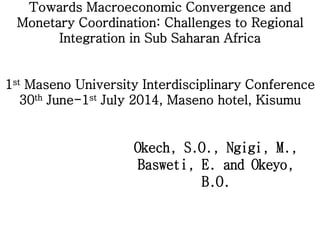Maseno conference
- 1. Towards Macroeconomic Convergence and Monetary Coordination: Challenges to Regional Integration in Sub Saharan Africa 1st Maseno University Interdisciplinary Conference 30th June-1st July 2014, Maseno hotel, Kisumu Okech, S.O., Ngigi, M., Basweti, E. and Okeyo, B.O.
- 2. Introduction Regional integration- Engines of sustainable growth Small nature of economies High inflation Instability of exchange rates Financial fragility The poor state of infrastructural services Outcome: Non-achievement of UNDP’s –MDGs Therefore, promoting macroeconomic integration (Monetary Union) is urgent in Africa
- 3. Introduction cont’d Africa: Present: 8 regional integrations (EAC,SADC,ECCAS,ECOWAS,IGAD,UMA,CEN -SAD,COMESA)– Promoting economic cooperation, Intra regional trade bargains (Market access) Management of shared infrastructure among members These blocs are considered to have made some real progress and are assumed to be on track to the achievement of the 2025 target of Monetary Union
- 4. Introduction cont’n With many ups and downs, a keen attention to their position today in terms of monetary convergence plan Pre-requisite: Urgent shift in approach and perceptions in overcoming the obstacles faced by their mentors-European and American integrations
- 5. RESULT AND DISCUSSION: TRADE LEVELS (2004-2014) -10 0 10 20 30 40 50 60 70 80 1 2 3 4 5 6 7 8 9 10 11 Averagetradevolumes(ImportsandExports) Year Volume of intra-regional trade in EAC and SADC countries (Billions) SADC Exports SADC Imports EAC Exports EAC Imports
- 6. RESULT AND DISCUSSION: UNDERLYING INFLATION (EAC-<5%) Country 2000 2005 2007 2008 2009 2010 2011 2012 2013 2014 Uganda 4.5 8.6 6.07 12.04 13.07 3.97 18.68 14.02 5.44 6.28 Tanzania 6.2 4.36 7.03 10.28 12.14 7.19 12.69 16 7.87 5.23 Rwanda 3.9 9.12 9.08 15.44 10.35 2.31 5.67 6.29 4.22 4.07 Kenya 6.8 7.82 4.27 15.1 10.55 4.31 14.02 9.38 5.72 6.59 Burundi 24.3 1.2 14.42 25.97 4.62 4.09 14.89 11.99 8.84 5.95 Average 9.14 6.22 8.174 15.766 10.146 4.374 13.19 11.536 6.418 5.624
- 7. SADC: Inflation (Target: Single digit -2008) SACU incl. CMA 2001 2005 2006 2007 2008 2009 2010 2011 2012 2013 2014 Botswana 6.6 8.61 11.55 7.08 12.623 8.12 6.95 8.46 7.53 5.76 3.8 Lesotho 6.9 3.44 6.08 8.01 10.716 7.38 3.60 4.99 6.18 5.31 4.66 Namibia 9.3 2.26 5.05 6.73 10.351 8.78 4.47 5.05 6.54 6.17 5.9 South Africa 5.7 3.39 4.69 7.09 11.536 7.13 4.27 5 5.65 5.75 5.98 Swaziland 7.5 1.75 5.2 8.08 12.657 7.45 4.509 6.12 8.94 5.62 5.52 Mauritius - 4.82 8.93 8.83 9.731 2.52 2.93 6.53 3.85 3.48 3.85 HIPCs Congo D.R. 357.3 21.39 13.21 16.72 17.97 46.22 23.46 15.54 2.13 0.81 2.37 Malawi 27.2 15.41 13.90 7.96 8.71 8.43 7.41 7.63 21.27 27.71 15.11 Mozambique 9 6.43 13.25 8.16 10.33 3.26 12.70 10.35 2.09 4.21 5.6 Tanzania 5.2 4.34 7.25 7.028 10.28 12.14 7.19 12.69 16.00 7.87 5.23 Zambia 21.7 18.33 9.02 10.66 12.45 13.39 8.5 8.66 6.58 6.98 7 Madag. - 18.36 10.77 10.36 9.17 8.96 9.28 10.02 5.81 5.83 6.22 In crisis Congo D.R. 357.3 21.39 13.21 16.71 17.96 46.22 23.46 15.54 2.13 0.81 2.37 Zimbabwe 76.7 -31.52 32.97 - 72.73 156.96 6.22 3.05 3.47 3.72 1.63 1.46 Angola 152.7 6.7 22.96 13.31 12.25 12.47 13.721 14.48 13.48 10.29 3.78 7.66
- 8. RESULT AND DISCUSSION: CURRENT ACCOUNT DEFICIT (Excl. grants)/ GDP ratio): Target: (-<5%) EAC 2000 2005 2007 2008 2009 2010 2011 2012 2013 2014 Burundi -7.0 -4.91 -5.36 -0.98 1.72 -12.20 -13.62 -17.26 -23.22 -21.51 Kenya -3.4 -1.46 -3.95 -6.51 -5.51 -7.35 -11.16 -10.45 -8.31 -9.62 Rwanda -3.3 1.01 -2.23 -4.88 -7.29 -5.42 -7.24 -11.44 -7.31 -11.54 Tanzania -5.3 -6.63 -10.95 -10.23 -9.76 -9.30 -14.55 -15.86 -14.29 -13.93 Uganda -6.5 -2.52 -5.53 -8.71 -7.34 -11.07 -12.49 -10.47 -11.67 -12.56
- 9. CHALLENGES TO MU Lack of monetary convergence criteria as a target (UEMOA, CEMAC, ECOWAS, EAC and SADC)  Membership to several blocs with competing and overlapping visions Confused policies and tariff rules: importation Lack of cost-benefit analysis criteria, low political commitment and internal consultation countries Vulnerability to internal and external shocks Slow trade and mobility of factors of production
- 10. POLICY RECOMMENDATION Prior internal consultations (public sector, private sector and civil society) Strengthening technical capacity and human capacity for informative analysis Creating of enabling institutional environment to attract finances for integration – reduce socioeconomic policy divergence Clarity of integration treaties, leadership, protocols and priorities Creation of common clearing house and central bank based on clear and realistic measurement parameters
- 11. THANK YOU










